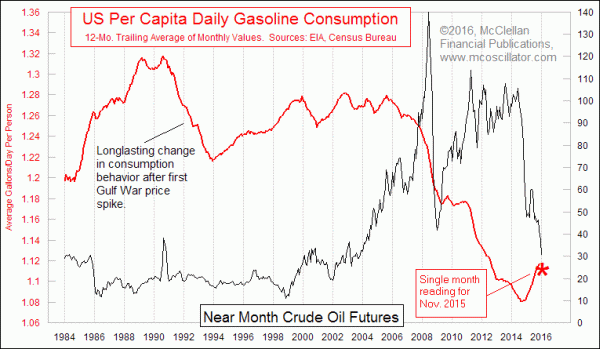Why Lower Gasoline Prices Are Not Stimulating Economy

Free Chart In Focus email
Delivered to you every week
Fed officials and financial news reporters are collectively wondering why the economy seems to be slowing down, even though lower oil and gasoline prices ought to be a stimulative factor. If consumers are spending less of their money on gasoline, then they ought to have more to spend on other stuff, or so goes the reasoning. So why is it not working?
The problem is one of magnitude, and most analysts fail to take the time to do the math. So at the risk of boring you with arithmetic, let’s look at some important numbers, with a bit of back-of-the-envelope math.
The EIA publishes data on consumption for a variety of energy products, including gasoline. In November 2015 for example (the most recent month for which there are data), Americans consumed gasoline at a rate of 358 million gallons per day. The 12-month average is 360 million gallons. That sounds like a really large number, but when you realize that there are roughly 322 million resident Americans, that works out to 1.11 gallons per day for every American.
The chart above shows the trend for that data. The high prices of just a couple of years ago sent people into dealerships to buy Priuses, Volts, Teslas, and other electrified cars to avoid paying high gasoline prices. But the falling prices for automobile fuel are making consumers eschew those more efficient choices, and consume more gasoline. They are also consuming more diesel, which is not part of these computations, but it is nevertheless a real factor.
Looking at the math, if the price of gasoline drops from $3.00 to $2.00 (round numbers to make the math easier), that means an extra $1.11 in your pocket every day, assuming you are the average man, woman, and child in America.
If you find a dollar on the sidewalk, pick it up and put it in your pocket, are you going to go out and adjust your spending patterns? Probably not. But if you found a dollar on the sidewalk every day for a month, or for several months, maybe you will start supersizing your Happy Meal, buying more Pokemon cards, or making other adjustments to your consumption. This is the point that former Fed Chairman Ben Bernanke made in his famous speech about dropping money from helicopters, a point he borrowed from Milton Friedman.
Aggregating all of those savings, a $1 drop in gasoline prices amounts to around $10.8 billion of supposed stimulus in the form of consumers keeping more of their own money. That’s $1 multiplied by an average of 360 million gallons per day, times 30 days in an average month. Now, $10.8 billion per month is a pretty big number, but it is nowhere near the $85 billion per month that the Fed was pumping into the banking system during QE3, for example.
Still, $10.8 billion per month ought to do something for stimulus, right? Yes, of course, but that is unless it gets eaten by monsters. Mwahh, hah hah!! The Robert Wood Johnson Foundation (RWJF) estimates that the average price of healthcare premia will rise by 12.56% in 2016, a figure way above the estimate of 5.8% per year as modeled by the Centers for Medicare and Medicaid Services for the 2014 to 2024 period.
The National Conference of State Legislatures estimates a US-wide cost for a “Silver” plan medical insurance for a 40-year-old non-smoker at $314 for 2015. So if we apply a 12.56% growth rate from RWJF, that amounts to a jump to $353, or $39/month. That pretty well eats up the $1.11 per day savings on gasoline.
Ergo, the stimulus of lower gasoline prices has been eaten by monsters.
One other monster eating the gasoline stimulus is that the federal government is now soaking up 18.1% of GDP in the form of federal taxes. Going above 18% has a proven track record of pushing the U.S. into a recession. So the bottom line is that whatever stimuli the lower prices of gasoline are giving us are getting swallowed by darker forces. And the magnitude of the savings is just not enough to outweigh those stronger forces. It would not even be enough if gasoline was free. And that’s the big takeaway message.
Tom McClellan
Editor, The McClellan Market Report
Apr 16, 2015
US Taxes Returning to Economy-Killing Level |
Jun 27, 2014
Still The Only Chart That Matters |
Dec 30, 2015
Dallas Fed’s Signs of Recession |